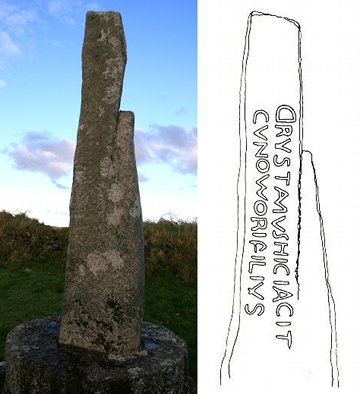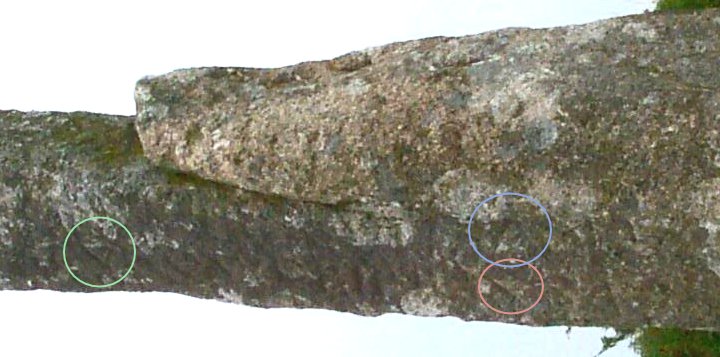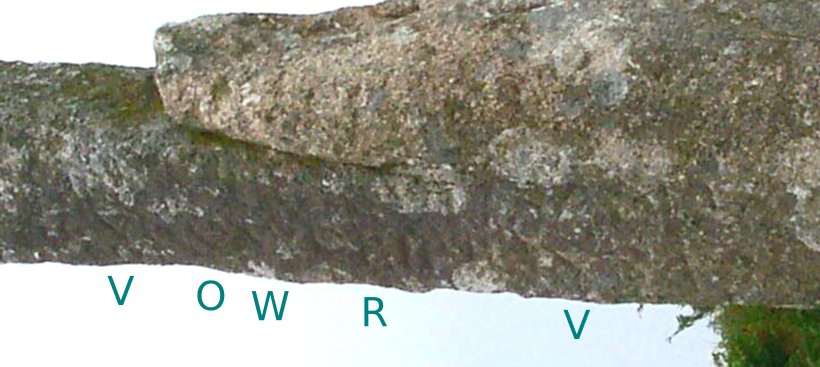

|
| Tristan Stone and Inscription (sources) |
|---|
This stone, on the A3082 near Fowey in Cornwall, is carved with an inscription in 6th Century AD Latin script, to the effect of commemorating a man named Drustanus, son of Cunowori. The name Drustanus may be considered a Cornish cognate or etymon of Tristan, the name of a character in the very widely known tale of Tristan and Iseult.
The inscription has not always been read as commorating a man named Drustanus. In the Antiquities of Cornwall (1679) by Borlasse, the inscription was given as “CIRVSIVS HIC IACIT CVNOWORI FILIVS”. An anonymous Cornish writer in a piece called On Cornish Crosses (1850) similarly gave the inscription as “+ CIRVSIVS HIC JAC-T CVNOWORI FILIVS”. The plaque at the site, however, placed by the Fowey Old Cornwall Society and presumably intended to reflect the modern consensus, gives the inscription as:
DRVSTANS HIC IACIT
CVNOWORI FILIVS
The D in DRVSTANS is written backwards, and the N in the same word is written backwards and ligated with the preceding A. The inscription, on the south side of the stone, is now very badly worn. The photo sequence below attempts to give a reconstruction as far as possible of what is currently legible.
An old print gives an anecdote about the stone as follows. “Carew gives a curious account of a ‘gentleman who was persuaded by some information or imagination that treasure lay hidden under this stone; wherefore in a fair mooneshine night, thither with certain good fellowes he hyeth to dig up:’ he then continues to relate that they were obliged to abandon their enterprise, and seek shelter, on account of a terrible thunderstorm; ‘whether this’ disturbance, he says, ‘procedith from a naturall accident, or a working of the diuell, I will not undertake to define.’”

From these identifications it is possible to overlay an old engraving of the inscription on the photo.


The match is not exact, of course, but it does allow us to estimate where the less legible characters are on the stone.

These are the letters in the bottom row that I can most reliably make out, based on the transcriptions from various sources, the overlays as given above, and a lot of very sketchy interpretation.
I took some notes in my usual note taking program and I decided to render notes from this year into HTML; so I did that and one of the most recent was a note about Hesperus; I looked up Hesperus on Wikipedia, wondering why there isn't a personification of the morning star; learned that there is, and it had a simple etymology, but the etymology of Hesperus wasn't given; so I tried to look up the Proto-Indo-European roots for Hesperus; meanwhile I found the usual PIE language family trees, and some work on how to reconstruct PIE myths and legends, basically PIE heroic poetry; some of that was echoed in various PIE-derivative languages, e.g. in the Celtic branch; so I had a page up on the Celtic myths, and got looking at the Welsh and Cornish myths specifically, one of which is Arthur; looked at that, and Tristan and Iseult; found out about the Tristan stone again, which I've seen before, and wondered what it looked like; looked it up and realised that the inscription was barely legible on any photographs, hence this page.
Compare also some background notes taken on Swhack.
Created January 2011, by Sean B. Palmer